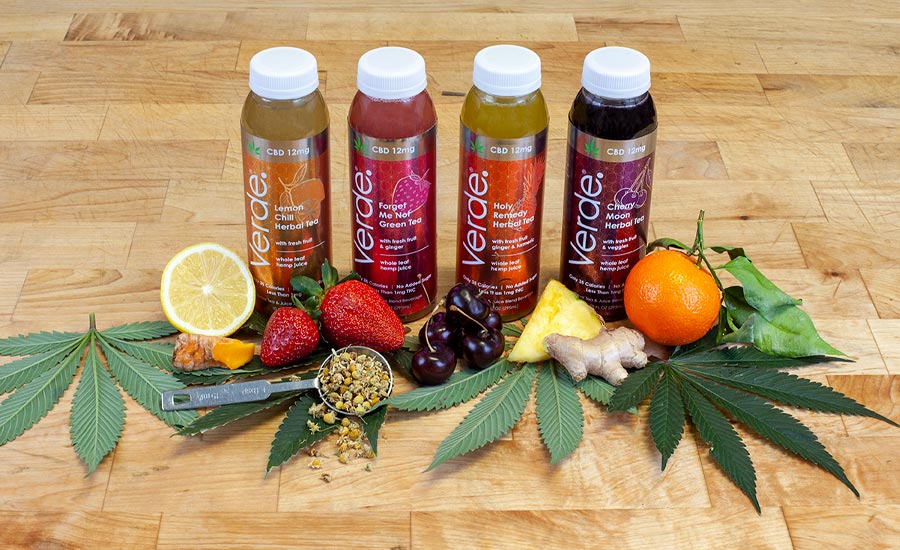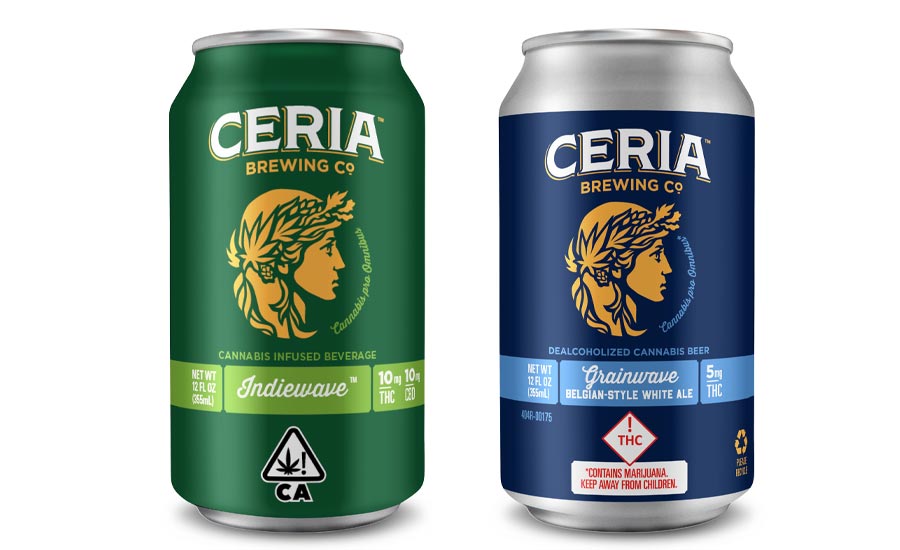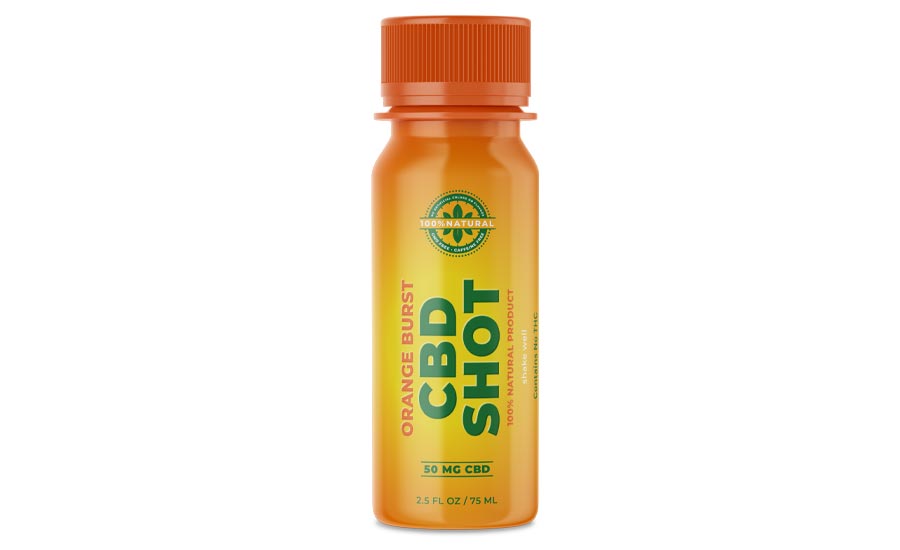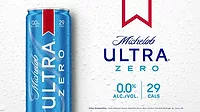Cover Feature
Business interest in $30B cannabis market up 140%
Canopy Growth inks partnership with Southern Glazer’s to expand distribution of its CBD-infused waters to seven states

The Hippie Movement of the 1960s and 1970s and the slogan “Make Love, Not War” was perpetuated by thousands of long-haired hippies and “flower children” wearing tie-dyed psychedelic T-shirts and headbands, granny-styled, rose-colored glasses and patched bell-bottoms gathering in droves to smoke grass, flash the peace sign and vehemently voice their opposition to the Vietnam War. Driving colorfully painted Volkswagen Beetles and Vans, the members of this counterculture rejected the norms of mainstream America with a movement that spread from college campuses, to Canada, Britain and beyond.
In 1969, 12 million Americans had tried pot, but today more than 140 million Americans have smoked it at least once, writes Brittney Sanger in the article “10 Things You’ll Understand If You Smoked Grass In the Hippie Days.”
“To put it another way, the population has jumped from 12 percent to 44 percent,” she says. “Then again, the Internet is a lot more popular now than it was in the hippie era, giving people easy access to the facts about the plant.”

(Image courtesy of Verde)
Growing gangbusters
The cannabis industry is figuratively growing like a weed. London-based Euromonitor International states that “legal cannabis is set to increase from $30 billion in 2020 to over $90 billion in 2025, as consumers increase their usage in diverse parts of their lives.”
Similarly, Seattle-based Headset, a provider of aggregate data and analytics across the legalized recreational and medical marijuana markets, reports substantial growth in the world’s largest and fastest-growing cannabis markets. In the United States, it projects cannabis sales to reach $23 billion in 2020 and $28 billion in 2022, while Canadian cannabis sales are significantly lower at $4 billion.
Yet, Headset forecasts that cannabis sales in Canada will grow exponentially; it is expected to grow twice as fast as the U.S. market between 2020 and 2021 and almost three times faster than 2021 to 2022.
But what do consumers really know about cannabis anyway? Not much, according to a study from St. Louis-based Invisbly. The data-driven company found that “58 percent of respondents didn't know the difference between CBD and THC-containing products such as marijuana, and probably because people don’t know the difference, 53 percent of respondents would not consider using a CBD product for any reason.”
In fact, there are distinct differences between CBD and THC. Although both are chemical compounds derived from the Cannabid sativa plant, or marijuana, THC, the main psychoactive compound in the cannabis plant, is responsible for the “high” or euphoria in humans’ experiences. Meanwhile, CBD, a naturally occurring substance derived directly from the hemp plant, could help consumers curb anxiety, pain, inflammation and insomnia, experts say.
A phytocannabinoid discovered in 1940, CBD is one of 113 identified cannabinoids in cannabis plants and accounts for as much as 40 percent of the plant’s extract. It also is the second most prevalent of the active ingredients within cannabis/marijuana, explains Rick Maturo, associate director of client services for Cannabis Practice at New York-based Nielsen.
THC, on the other hand, contains three strains: cannabis sativa, which provides the “cerebral rush” or psychedelic high; cannabis indica, which is responsible for a “relaxing” full body high; and cannabris hybrid, which is a combination of the two, he adds.
“In 2020 legal cannabis sales in the U.S. were $20 billion — inclusive of all legal regulated marijuana sales and hemp-derived cannabinoid-containing products,” Maturo says. “By comparison, NielsenIQ reports that off-premise (i.e., retail) sales of beer, wine, and spirits in Nielsen-tracked channels were $89 billion, whereas off-premise (i.e., retail) sales of non-alcoholic beverages in Nielsen-tracked channels were $86.5 billion.”
Los Angeles-based IBISWorld’s March “Medical & Recreational Marijuana Growing” report pinpoints that indica products account for industry revenue as follows: cannabis hybrid products are No. 1 at 54.1 percent of consumer sales; indicia marijuana products provide 24 percent of revenue; and sativa products account for 21.9 percent of revenue.
From 2016-2021, the medial and recreational marijuana market generated $11.6 billion in revenue, experienced a profit of $1.5 billion, and is expected to grow at an annualized rate of 28.1 percent through 2021, and to grow 18.3 percent through 2026, the report states. Cannabis businesses also are contributing to the economy with a 25.8 percent growth rate and a total of 28,714 businesses employing 120,000 people with annual wages of $3 billion.
Trends spurring growth
Among the key trends spurring growth, IBISWorld’s report notes that more states have recently moved to legalize marijuana for medical purposes. The strong demand growth is enticing companies to enter the growing industry, it notes. Additionally, the movement to decriminalize recreational marijuana and legislative victories are fueling strong growth for industry operations who foresee many opportunities for growth.
However, many businesses run the risk of being shut down or experience a property seizure without notice, it reports. This likely is due to the fact that not every cannabis business is federally regulated, says Brigette Thomas, industry research analyst at IBISWorld and author of the aforementioned report.
She notes that the differing regulations state to state are the biggest barrier for the cannabis industry.
“Since the use of marijuana is not legal at the federal level, laws surrounding the industry vary from state to state. This effectively stops companies from being able to expand or capture a large market share,” Thomas explains. “However, over the past five years, legalization has increased throughout the country. As of the November 2020 elections, 34 states have some regulation that permit the use of medical marijuana and 15 states have permitted the legal sale of cannabis for recreational use for consumers over the age of 21.
“The 15 states that have legalized the recreational use of marijuana are Alaska, Arizona, California, Colorado, Illinois, Maine, Massachusetts, Michigan, Montana, Nevada, New Jersey, Oregon, South Dakota, Vermont and Washington, along with Washington D.C.,” she continues. “Additionally, on March 25, 2021, New York lawmakers had reached a deal to legalize recreational marijuana. However, it should be noted that at the time of writing, the official law has not been passed. Although this process is expected to take around a year to take effect, if approved, it shows how quickly the regulatory environment surrounding the industry is changing.”
Nielsen’s Maturo adds: “From the legal marijuana side, I think usage is both a positive and negative, but at this point, it’s probably a wash. In the future, it will be perceived as a positive because most of the largest and innovative beverage companies are now aligned with at least one cannabis company. And furthermore, they know they’ve got to get in before they would have to pay much higher prices to acquire these companies outright to make a foray into the industry.”
Ranjana Sundaresan, lead research analyst at Minneapolis-based Spoonshot, also notes that the complex legal ramifications and regulatory uncertainty are impacting the usage of CBD and THC within beverages.

(Images courtesy of CERIA Brewing Co.)
“The regulatory landscape for cannabis in the U.S. is rather complex since states are allowed to make their own call with regard to the use of cannabis across all of its forms, including CBD and THC, as well as their incorporation in food and drink,” she explains. “However, at the federal level, the use of cannabis compounds is still not allowed — the FDA does not consider CBD a legal dietary ingredient. This means that, among other things, companies cannot make products in one state and ship them to another, as is often the case with most food and drink. Because of the federal regulation, the FDA has also called for the recall of several products containing CBD sold in supermarkets or other retail stores.”
However, new product development, more availability of diverse products, more states on board and the growing acceptance of marijuana use among all demographics is spurring growth, IBISWorld’s Nelson says.
“Additionally, new forms of cannabis products [are] continuously being introduced to the market,” she says. “Not only does this appeal to existing cannabis users, it also opens the market to potential new customers by appealing to different tastes and preferences.
“For example, edible cannabis products appeal to consumers who don’t wish to inhale or worry about a lingering smell,” Nelson continues. “Overall, the more variety of cannabis products offered, the more potential customers there will be.”
Perhaps contributing to the high growth in the cannabis market is the fact that consumers don’t have to puff to get high. Today’s cannabis products come in many forms — from edibles like gummies and chocolates, to oils, lotions, creams and tinctures. In the beverage market, CBD- and THC-infused non-alcohol beverages are driving the innovation including flavored still and sparkling waters, juices and ready-to-drink teas and coffees.
“Based on our data, business interest in cannabis product launches specifically has grown by a whopping 852 percent since 2016. The leading beverage sub-categories to have CBD as an ingredient were tea, flavored/functional water, and coffee,” Spoonshot’s Sundaresan says.
Launched in February 2021 by CEO Kelly Egolf, Verde, a functional tea and juice blend, is formulated with adaptogenic cold-brew teas and cold-pressed juices made from whole leaf, cold-press hemp leaves. Each 10-ounce bottle is preserved with high-pressure processing (HPP) and contains 35 calories with zero added sugar. They are available in four flavors — Cherry Moon, Lemon Chill, Forget Me Not and Holy Remedy.
“Verde Adaptogenic Tea with Hemp Juice uses HPP to preserve the nutrients in whole leaf hemp juice. Traditional heat pasteurization destroys the hemp juice’s nutrients,” the CEO says. “Other CBD beverages use hemp seed oil.”
When discussing the impact of legal cannabis’ — particularly marijuana — impact on the alcohol and non-alcohol (NA) industry, Nielsen’s Maturo suggest that the far-reaching negative implications for beverage alcohol is “much less dire” than many would have anticipated.

(Image courtesy of Bawi Mana Holding LLC)
Overall, legal cannabis has not yet made much of a dent in actual alcohol sales, he says. “Sales are typically negatively impacted in low single digits before market conditions stabilize. From what we’ve observed, off-premise (i.e., retail) sales are more impacted than on-premise sales; and in terms of super-categories, beer is hit hardest, followed by spirits, with wine seeing the smallest and a notably smaller negative impact on sales,” Maturo explains. “Specific to beer, sub-premium domestic brands, and especially those with higher ABV, tend to see greater impact than craft, imported, and non-sub-premium domestic brands.
“That said, between 30-40 percent of beverage alcohol drinkers that indicate they are likely to consume a marijuana product in the next 12 months say they have already or plan to decrease their beverage alcohol consumption as the result of using marijuana,” he continues. “We also know that more than a quarter indicate that when they consume marijuana, they consume fewer drinks.”
When asked why some consumers are shifting from beverage alcohol to cannabis, Maturo points out it’s rooted in health perceptions because marijuana has fewer calories and is perceived healthier for one’s body and mind.
“Other reasons are tied to how marijuana makes people feel compared to alcohol — consumption doesn’t lead to hangover, consumption doesn’t lead to bloating or feeling full; and others perceive marijuana as having a wider variety of uses,” Maturo says.
Rooted in health and well-being
In researching the business interest of alcohol beverages, Spoonshot’s Sundaresan notes that since January 2018, “business interest in alcohol beverages has declined by 9 percent, while interest in cannabis has gone up by 140 percent and interest in low/no-alcohol beverages has gone up by 41 percent,” she says. Within the past three years, consumer interest in cannabis has gone up 60 percent, she adds.
“We found a high negative correlation (-0.71) between alcohol and cannabis in the business space, indicating that declining interest in alcohol corresponded with increased interest in cannabis and its compounds (primarily CBD),” Sundaresan says. “There was also a strong positive correlation (0.94) between low/no-alcohol beverages, which underscores the view that consumers are focusing increasingly to improving their health, both physical and mental, by avoiding or moderating food and drink that may be harmful to their well-being.”
Research from Nielsen suggests a similar viewpoint, pointing out that the interaction and impact between marijuana and beverage alcohol have clearly overlapping need states — such as experience enhancement, mood modulation and socialization. As a result, hemp-CBD beverages could pose a slight threat to beverage alcohol once it become more ubiquitous and hits the shelves of national chain retailers, Maturo says.
“To this extent, we see hemp-CBD infused-beverages fitting in where mocktails, NA beers, and other NA-alcohol-style beverages are gaining traction, but with an additional element of being positioned as a ‘functional’ beverage for needs surrounding relaxation/stress relief, sleep, focus, etc.,” he says.
From August 2019 through September 2020, claimed usage of legal cannabis products was up almost 10 percent (29 percent vs. 31 percent), he says, citing NielsenIQ’s “Thinking Beyond the Buzz Study US.” Similar increases were reported for THC-dominant legal marijuana products.
The amount of sales also depends on the maturity of the state compliant agency in legal markets. For instance, Colorado reached nearly $2.2 billion and $1.75 billion in sales in 2020 and 2019, respectively. For hemp-derived CBD products, which are predominantly sold outside of medical dispensaries or in specialty brick-and-mortar stores, incidence increased by more than 25 percent (15 percent vs. 19 percent) comparing 2019 to 2020, Maturo says.
A groundbreaking, strategic partnership
As a result of CBD and THC’s growth and demand, cannabis companies are looking to partner with leaders in the beverage industry. In 2020, Smith Falls, Canada and New York-based Canopy Growth Corp., a leading diversified cannabis, CBD and vaporization device company, launched Quatreau, a new CBD-infused sparkling water in Canada, where now it’s the top-selling ready-to-drink (RTD) CBD beverage, the company says.
Following Quatreau’s successful rollout in Canada, in March, Canopy rolled out its first line of CBD-infused beverages to U.S. retailers and eCommerce in four RTD flavors: Cucumber + Mint, Passionfruit + Guava, Ginger + Lime and Blueberry + Acai. The functional, zero-sugar drink delivers a natural, low-calorie beverage alternative with 20 mg of premium, U.S. grown hemp and just 25 calories in each 12-ounce slim can.
To create a route to market for Quatreau, as well as other CBD and eventually THC beverages and products when permissible, in April. Canopy Growth inked a U.S. distribution agreement with Southern Glazer’s Wine & Spirits (SGWS), Miami and Dallas.
The move was facilitated by global beverage leader Constellation Brands, Victor, N.Y., which owns 38.6 percent of Canopy Growth and uses SGWS to distribute 70 percent of their own portfolio, the company says.
“Through this groundbreaking partnership, we will leverage Southern Glazer’s established distribution network to bring our CBD beverage portfolio to retailers and consumers across the U.S. market," said Julious Grant, chief commercial officer for Canopy Growth, in a statement. “The leadership team at Southern Glazer’s shares our values, priorities, and future-forward view of the category. Together, we are committed to creating an immediate strategic route to market for Canopy’s premium CBD beverages.”
Southern Glazer’s will distribute Canopy Growth’s CBD beverages, beginning with the company’s first CBD-infused sparkling water brand Quatreau in seven states: Arizona, Florida, Kansas, Missouri, New Mexico, Nevada and Oregon, with more to come. SGWS also will be selling the flavored sparkling CBD water through its existing commercial infrastructure, including its Proof eCommerce platform.
Engaging consumers with a future-forward approach
Beverage manufacturers continue to bring new, functional CBD and TCH beverages to market to entice and engage consumers. Los Angeles-based NXT Water released AKESO Hemp Powered Hydration, the company’s new 10 mg broad spectrum CBD water. Named after the Greek goddess of healing and curing, AKESO integrates 10 mg of broad-spectrum hemp-derived CBD and electrolytes into ultra-purified still water without any calories, sugar or artificial additives.
Mesquite, Texas-based Pickle Juice launched a sister company — Bawi Mana Holding LLC — to bring functional and emerging products to market, beginning with their 100 percent natural Orange Burst CBD Shot designed to provide various benefits to aid in pain, inflammation, anxiety and stress reduction.
Available in a light, tangy orange citrus flavor, each 2.5-ounce shot contains three all-natural ingredients: purified water, 50 mg of nano-emulsified broad-spectrum CBD and blood orange extract. It’s also formulated with zero artificial ingredients, zero sugar, zero caffeine and zero THC.
On the alcohol side, there’s Cannananda Wine, a sugary red Spanish wine that features CBD hemp extract in its formula. CERIA Brewing Co., Arvada, Colo., offers Grainwave and Indiewave IPA, infused with 5 mg and 10 mg, respectively, of fast-acting THC that leaves no cannabis flavor, the company says.
We’ve come a long way, baby
Now 50 years removed from the Hippie Movement of the ‘60s and ’70s, medical and recreational marijuana, pain-relieving edibles like gummies and tinctures are being used by a diverse consumer base.
Yet, with no standard regulations in place, it has impacted launches and the growth of the cannabis space, Spoonsot’s Sundaresan says. “In the last year, business interest in product launches with CBD as an ingredient declined 61 percent. All 50 states in the U.S. have legalized the use of CBD sourced from hemp, but different states have different laws with regard to the use of CBD in products.
“According to Spoonshot data, among food and drink products infused with CBD, beverages accounted for 27 percent, making this category the second largest for CBD use after supplements,” she continues. “Despite this, CBD is by no means a mainstay ingredient for the category. In the beverages space, significantly less than 1 percent of launches (<0.1 percent) had CBD as an ingredient.”
While experts note the future and adoption of a more formal process for the sale and distribution of CBD-infused products is needed, more research into the ingredients’ ability to provide anti-stress and anti-anxiety attributes in functional beverages also is necessary.
Yet, Nielsen’s Maturo notes that cannabis beverages are a hot format right now and with FDA guidance, nano-emulsion technologies and continued development, the category will continue to grow.
Yet, he cautions that the higher price point for flowers, vapes and edibles versus the experience enhancement, social enablement and lower cost of alcohol beverages could keep some consumers away. But with technological advances and the evolution of bio-synthesized cannabinoids, extraction and infusion might become easier, facilitating the pricing of cannabis beverages to dramatically drop.
“We believe the beverage industry is in for a very exciting ride over the next few years as cannabis becomes both an incredible opportunity and a risk and fully expect major players including those actively selling beverage alcohol, non-beverage alcohol, and even non-beverage products will actively be engaged with cannabis,” Maturo says. “As cannabis legalization continues to expand there is also potential that cannabis beverages may find their way into the on-premise marketplace as well. This can include hemp-CBD infused coffees at large coffee shops and quick service restaurants, and even THC infused beverages in various adult on-premise venues.”
Looking for a reprint of this article?
From high-res PDFs to custom plaques, order your copy today!



